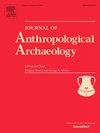Dearly De-Parted: Ancestors, body partibility, and making place at Dos Hombres, Belize
IF 2.2
1区 社会学
Q1 ANTHROPOLOGY
引用次数: 0
Abstract
Interments of Ancestors linked past peoples with the living. However, less attention has been given to secondary burials and their role in social memory and placemaking. Given these ties between Ancestors, the living, and the landscape, Ancestors may have been brought when descendants moved from place to place. I applied biogeochemical methods to address questions about movement, placemaking, and ancestry. In this paper I present isotopic data from a non-elite Late Preclassic (300 BCE – 250 CE), simple, co-burial from the archaeological site of Dos Hombres, Belize. Archaeological evidence indicates multiple ancestral veneration practices were associated with this burial. I measured oxygen and strontium isotopes to assess whether individuals were born where they were buried and to gauge how bodies may have been used to make and claim place. Strontium isotope ratios and δ18O values suggest the primary individual was local to Dos Hombres; however, the secondary individuals have strontium isotope ratios which fall outside the local range, indicating these individuals were non-local. In this paper, I argue that the practice of removing and reburying pieces of Ancestors’ bodies was used by the ancient Maya at Dos Hombres to claim and make place.
亲爱的分离:祖先,身体分离,在伯利兹的Dos Hombres安家
祖先的埋葬将过去的人们与活着的人联系在一起。然而,人们很少关注二次埋葬及其在社会记忆和场所塑造中的作用。考虑到祖先、生者和景观之间的这些联系,祖先可能是随着后代从一个地方迁移到另一个地方而被带来的。我运用生物地球化学的方法来解决关于运动、场所形成和祖先的问题。在本文中,我介绍了来自伯利兹Dos Hombres考古遗址的非精英前古典晚期(公元前300年-公元250年)的简单共葬的同位素数据。考古证据表明,多种祖先的崇拜活动与这种埋葬有关。我测量了氧和锶的同位素,以评估个体是否出生在他们被埋葬的地方,并衡量尸体可能是如何被用来制造和占有位置的。锶同位素比值和δ18O值表明原始个体来自Dos Hombres;次生个体的锶同位素比值超出了局地范围,表明次生个体是非局地个体。在这篇论文中,我认为移走和重新埋葬祖先尸体的做法是古玛雅人在Dos Hombres使用的,以认领和安置。
本文章由计算机程序翻译,如有差异,请以英文原文为准。
求助全文
约1分钟内获得全文
求助全文
来源期刊

Journal of Anthropological Archaeology
Multiple-
CiteScore
4.00
自引率
11.10%
发文量
64
期刊介绍:
An innovative, international publication, the Journal of Anthropological Archaeology is devoted to the development of theory and, in a broad sense, methodology for the systematic and rigorous understanding of the organization, operation, and evolution of human societies. The discipline served by the journal is characterized by its goals and approach, not by geographical or temporal bounds. The data utilized or treated range from the earliest archaeological evidence for the emergence of human culture to historically documented societies and the contemporary observations of the ethnographer, ethnoarchaeologist, sociologist, or geographer. These subjects appear in the journal as examples of cultural organization, operation, and evolution, not as specific historical phenomena.
 求助内容:
求助内容: 应助结果提醒方式:
应助结果提醒方式:


